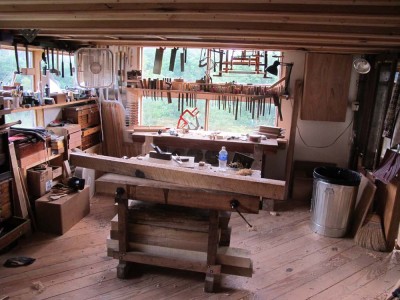An Old Friend Joins Me
When back in the city last week I disassembled and loaded my first real workbench, a 5″ thick torsion-box mounted on an oak base unit, and brought it back to the mountains when I returned.
Reassembled and in its rightful place — it was designed and is intended for use in “the middle of the floor” rather than against the wall — its diminutive size makes it a near perfect fit almost anywhere, and the space between the Roubo bench in the window and the planing beam makes it an integral part of the shop activities. NOW The Barn feels like home. It was home-y before, now it is home.
I built this bench in 1986 as I recall, using a pair of “Closeout table” vise screws from the local Woodcraft for the full length twin screw face vise, which is unbelievably handy. The Emmert was mounted a few years later, and I remember listening to the debates prior to the first Persian Gulf War on the radio as I was rasslin’ the beast into place.
The only real downsides to this bench are three. 1) it is really small, as was dictated by the space I had back then. At 24′ x 48″ for the core unit and 32″ x 54″ overall, it does limit the kinds of work you can do, but I have managed to do a lot with it over the years. 2) With the 90-pound Emmert vise hanging outside the trestle base, it does get kinda tippy especially when you put something heavy in it. I found that using the base as a lumber storage rack pretty much solves the problem. And 3) there was no end vise function, which I solved by designing and building the face-mounted end vise on it, a project that was featured in Popular Woodworking.
This bench has served me superbly for the better part of three decades and uncounted projects ranging from planing window trim to being a toy hospital to fabricating parts and even entire replicas) for priceless antiques and everything in between. If you have a severe space restriction for your working area, you might want to give something like this a thought. If so, I will be delighted to provide any insights and counsel I can to help you along.
But tread lightly when contemplating acquiring an Emmert. If you do try one out, be forewarned that a complete one in excellent shape often costs a fortune. In addition you will have to suffer the discomfort of kicking yourself non-stop for not having one before. There is also the continued annoying (to other woodworkers) habit of comparing everything to an Emmert from this point on. Frankly, nothing else measures up. Thanks to Benchcrafted and others we are living in a Golden Age for woodworker’s vises, but this standard is what keeps me looking for improvements all the time. Even when we get to fabricating Studley vises, this will probably remain my “go to” tool.




Join the Conversation!